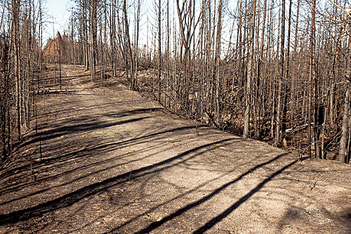Northern Minnesota boasts one of the world’s premier canoeing destinations: the Boundary Waters Canoe Area Wilderness. The name says it all—the BWCAW is a canoeing paradise. Find a canoe you can comfortably portage, grab a paddle and a pack, and suddenly you can go almost anywhere in a vast 1,000,000-acre wilderness.
But what about those adventurers among us who think a little bit differently? Those who question, shouldn’t the BWCAW also provide amazing possibilities for challenging, remote hiking? After all, there’s a lot of land in this protected wilderness too… These free thinkers see an opportunity not to fight for the last open campsite on a crowded lake, but rather to experience the wilderness for what it truly can be: a place of absolute solitude. They’re ready to earn this remote solitude with their own two feet.
For Martin Kubik, who has been hiking the BWCAW since the 1970s after immigrating with his family to the U.S. from Czechoslovakia, it’s the hiking that puts the “W” in BWCA-Wilderness. “When you hike the Superior Hiking Trail, you can hear the road from many places. When you hike the Powwow Trail, you’re really out there. It’s Alaska four hours from the Twin Cities. There’s a sense of adventure, exploration, and the unknown.”
Logging Roads to Hiking Trails
Ken Hupila, who moved to Ely in 1978 and has been hiking BWCAW trails ever since, also sees the beauty of these trails through the history they represent.
Hupila credits the use of fire towers as one of the precursors of today’s wilderness hiking routes. “A lot of the hiking trails in the BWCAW today are associated with old fire towers. There were a couple of real bad fires up in this area about 1910, and by 1911 the Forest Service had gone in and put in 50 towers from what is now one end of the Boundary Waters to the other. They pared that number down a little over time, but the remaining towers were manned until the 1950s.”
Hupila previously worked as a canoe guide during summer months, and focused on recounting the Boundary Waters rich human history to his clients. He read and researched the lives of the Ojibwe and the voyageurs, as well as the more modern history of logging and mining in the area.
He learned that the logging companies in effect laid the foundation for BWCAW hiking trails by developing forest roads, and even railroads, that went to some of the fire towers. As time went on, and the BWCAW became protected in the second half of the 20th century, logging railroads were taken out first, and then the logging roads were abandoned as well. These arteries were quickly overtaken by the forest again.

There were some exceptions too, as Hupila discovered. “In the cases of some trails, namely the Sioux-Hustler Trail, the Angleworm Trail, the Kekekabic Trail, and the Powwow Trail, the Forest Service decided to try and create another recreational activity that could be done using the previous roadbed. That’s how the hiking trails came to be.”
Death of a Trail?
Take the Powwow Trail, one that Kubik and Hupila and teams of other volunteers have worked on reclaiming from 2016 to the present due to sporadic maintenance by the U.S. Forest Service after the Pagami Creek Wildfire of 2011. In an October 2015 press release, the Forest Service announced that it would no longer maintain the trail. At one time, Kubik was told by a District Ranger that the Forest Service plan was to let the trail go, then come back 30 years later and re-establish it when the post-fire forest canopy grew back up. Kubik, now 71 years old, didn’t want to wait that long.
Hupila recounts the history of how the Powwow trail originally came to be. “The Tomahawk Lumber Company had a series of camps in the Babbitt area. As they logged out an area, they would move along and set up a new camp. Forest Center became their last camp, and it turned into a small city up in the wilderness. At one point there were about 600 people there. They had a grocery store, a church, and an elementary school. They had a sawmill there and a railroad that came in. They would log the surrounding area, bring the product into the sawmill, saw it up, and ship it out to the rest of the country from there.”
When the 1964 BWCAW Act was passed, the whole area where Tomahawk was operating was put off limits to logging, thereby eliminating the life source of Forest Center, and other area logging camps.
The Forest Service in turn converted the existing roads into hiking trails, cutting through the woods to complete loops in places where the old roads didn’t make a complete circle.
Hupila then watched the Powwow Trail practically disappear over the next three decades, until the Pagami Creek Wildfire in 2011, when all of a sudden everything was opened up again.
“Suddenly you could see the old roadbed again, and see all the remnants of the old logging camps,” says Hupila.
Modern-day Trail Maintenance: The Volunteer Model
Enter the Boundary Waters Advisory Committee (BWAC)—a citizen-run volunteer trail maintenance organization with a mission of preserving existing historic and intrinsically beautiful trails in the BWCAW of the Superior National Forest. BWAC blends stewardship, education, and advocacy for keeping trails maintained and opened for hikers.

Maintaining a wilderness hiking trail isn’t easy. Not with constant windstorms, forest fires, and yearly growth of underbrush encroaching on historic trails. In some cases, the Forest Service gives up trying. That’s why Kubik founded BWAC in 2002.
Kubik earned his chops leading grassroots trail maintenance expeditions to remote parts of the BWCAW as early as 1990.
He first hiked the length of the 40-mile Kekekabic Trail, from the Gunflint Trail west to Snowbank Lake, in two days in 1979. After 10 more years of continually enjoying the rarely-used trail, Kubik found it becoming more and more overgrown. He decided something had to be done, and says he had two choices: write to his state representatives to increase taxes, or go do something about it himself. He chose the latter.
Kubik recruited 115 fellow employees from 3M, where he was an electrical engineer, to go volunteer with him in 1990 to re-establish the Kekekabic. Together they cleared 3,000 tree falls over the Kekekabic’s 40 miles over the course of a year.
Kubik still remembers the days before the public needed to pick up the slack. “In the 1960s the Forest Service had hundreds of seasonal workers. When I was a young man in 1974 or so, I backpacked the Kek, and in one place the Forest Service staff took a scythe and mowed the ferns. It was incredible. Back then they could use a helicopter to deliver lumber, so they had planks over wetlands. Now, after the passage of the 1978 Wilderness Act, they don’t do that anymore. The Kek was the first trail where they ceased maintenance in the 1980s, and we reclaimed it in 1990.”
With help of pro bono attorneys who negotiated and secured permission from the Forest Service for the BWAC, volunteers were ready to put their collective sweat equity into cleaning up the Powwow Trail. Five years later, in October 2021, a joint ceremony was held to open a new hiker’s kiosk on the edge of the BWCAW, celebrating the reopening of the 28-mile trail.
Kubik says that a multi-pronged approach of contacting the legislature, writing articles, and making countless presentations to the public on BWCAW trail reclamation projects is key to getting Forest Service permission to go in and work (with hand tools) on hiking trail maintenance. “To be an effective advocate for trails with the Forest Service, you need to have persistence,” says Kubik.
Today BWAC is thriving, with hundreds of members throughout Minnesota. In Kubik’s words, “There were some concerns 10 years ago, but then somebody discovered Facebook. Social media gets the message out and gets people involved.”

BWAC runs on a budget of $12,000 a year, mainly used for procuring tools like hand saws and loppers needed for trail clearing. As Kubik sees it, “Our budget is small, but what makes this organization go is passion. You can’t buy that. You can’t hire somebody to instill passion. It has to come from the heart.”
Kubik and his team strongly believe that “As long as there are people willing to maintain these trails, there’s no reason why they shouldn’t be open to the public.”
Take a Hike
Today, thanks to joint efforts between the U.S. Forest Service and volunteer maintenance organizations like the BWAC, the Border Route Trail Association, and the Kekekabic Trail Club, hikers have the best conditions that have existed in years for exploring the BWCAW by foot.
Hupila and Kubik’s final advice for those adventurous souls ready to go deep down the BWCAW’s hiking trails: be prepared.
“You’re going to find a lot less people, more primitive conditions, and it’s going to be more a feeling of wilderness,” says Hupila. “On the Powwow Trail, if you do the whole circle, you may run into one or two parties, or maybe not.”
Kubik concurs. “These trails are not for a casual hiker. They are challenging. But they offer an escape from corporate life, and a sense of freedom from daily obligations. You can be who you are.”
The romance of BWCAW hiking trails pulls strong on Kubik, Hupila, and other dedicated volunteers. These passionate advocates have gone the extra mile, both when hiking deep into the wilderness, and by taking responsibility for maintaining trails the Forest Service can’t get to.





